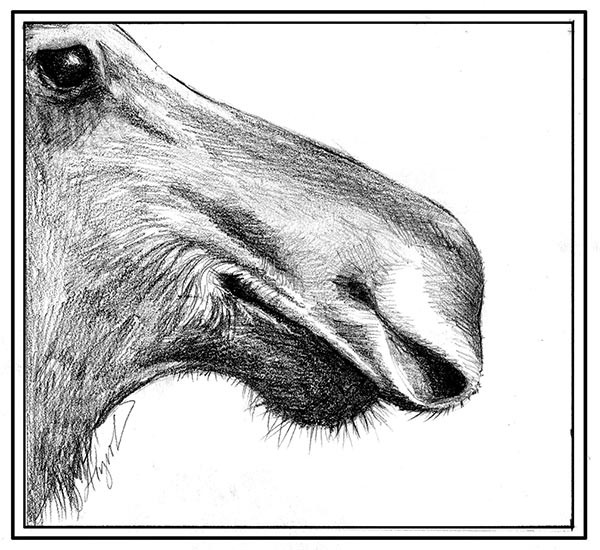
The silhouette of a moose is noticeably different from that of its deer cousins. Its bulky, hunched body sits on tall, improbably proportioned legs. And then there’s that nose. It’s long and broad – a full sixty-five percent of the moose’s head length – with enlarged nostrils that are positioned not in the front of the face, but off to the sides. By the nose alone, there’s little chance of mistaking Bullwinkle for Bambi.
There are traditional explanations for the moose’s unusual looking nose. Wabanaki tribes share tales of the hero Gluskap, who squeezed the moose, shrinking him from a giant’s size and creating an animal with a bulging proboscis. As for a scientific explanation, recent research suggests at least two possibilities.
Dr. Lawrence Witmer of Ohio University conducted an extensive study of the animals’ narial (nose) anatomy. Working with roadkill moose heads, and also the heads of whitetail deer, he used both simple dissection techniques and high tech approaches such as CT scanning to compare the two animals. His research, first published in 2004, suggests that moose noses may have at least two advantages that other deer, and most other mammals, lack: stereolfaction and waterproof nasal passages.
To understand stereolfaction, consider the way humans see. Each one of our eyes takes in a distinct field of vision, which, when combined in the brain, allows us to determine distance. Stereolfaction involves a similar process, except that it’s based on the sense of smell. According to Witmer, “moose, with their widely separated nostrils, may have enough separation that each nostril samples a different part of a gradient, allowing the animal to orient easily and track odors.” In other words, thanks to their big noses, moose may be receiving two fields of scent, strengthening their ability to determine the location and distance of smells.
This heightened sense of smell would be helpful in searching for food or danger, and also, perhaps, to mating. Moose rely on long distance scent detection to coordinate mating, so there is a strong evolutionary reason for them to have developed a special ability to track down a scent’s direction.
A second finding of Witmer’s study is that there are specialized structures within moose nostrils that automatically seal off the nose from water. According to Witmer, “mammals all tend to be able to open their nostrils (like humans “flaring” their nostrils), but relatively few can close them with muscles. Moose seem to do it not with muscles but rather by expanding the size of a pad of connective tissue due to the pressure of water.”
This adaptation has obvious advantages for moose, which are far more dependent on aquatic habitats than other deer species. They consume large amounts of aquatic vegetation, and it’s not uncommon to see moose standing in the middle of wetlands, their heads fully submerged as they graze on underwater plants. Aquatic habitats also provide moose refuge from insects and from heat: because of their size and thick coats, moose are especially susceptible to heat stress which, on a calm day, begins at just 62 degrees.
Moose are great swimmers, and can submerge completely for thirty seconds or more. They even dive, to depths of up to five meters – and their self-sealing nose facilitates this. “The deeper they dive, the greater the pressure, the tighter the seal,” said Witmer. “It’s basically a valve.”
Of course, that’s a scientist’s take. The Penobscots of Maine and the Mic’Maqs of Nova Scotia both have creation myths that hold that moose came from the sea, originating from whales, and can return there for refuge.
Figuratively speaking, this might not be very far off.

